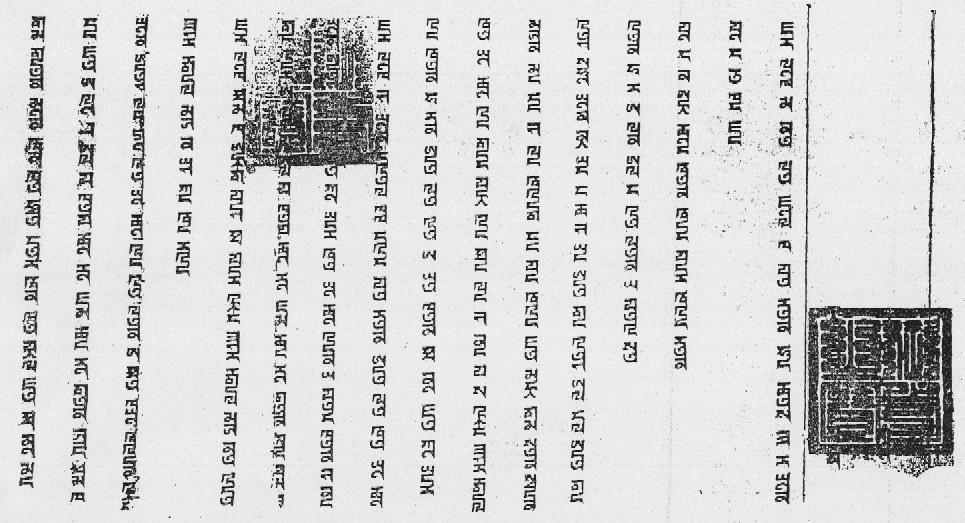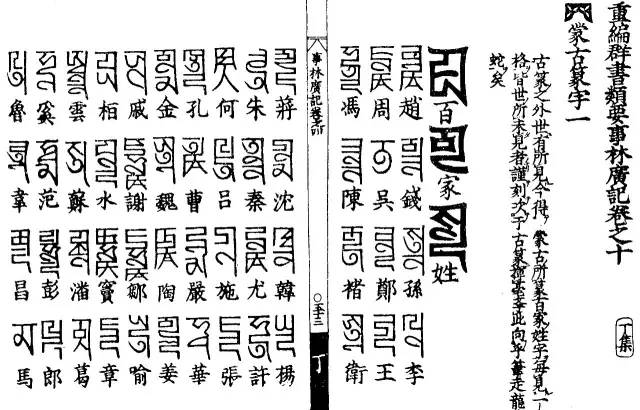yì‐xiāng‐qíngyuàn ((yì one 一)‐(xiāng side’s 厢 廂)‐(qíng·yuàn feelings’; sentiments’; emotions’; sensibilities’ · {being willing/ready; wanting → [hope; wish; desire]} 情愿 情願) → [one-sided wish; one’s own wishful thinking]) ← Tap/click to show/hide the “flashcard”
[Notes: Tap/click on a Pīnyīn (Pīn·yīn {Piecing Together of} · Sounds → [Pinyin] 拼音) expression to reveal its “flashcard”; tap/click on a “flashcard” or its Pīnyīn (Pīn·yīn {Piecing Together of} · Sounds → [Pinyin] 拼音) expression to hide the “flashcard”. 📖 📄 📘 icons mean 📖 Reveal All, 📄 Reveal Advanced, and 📘 Reveal None re all the “flashcards” in the heading, paragraph, etc. that they are placed at the beginning of.]
The Shēngmìng Láizì Chuàngzào Ma? ((Shēngmìng Life 生命) (Lái·zì Came · From 来自 來自) (Chuàng·zào Initiating · {Making, Creating} → [Creating] 创造 創造) (Ma [? ptcl for “yes/no” questions] 吗 嗎)? → [Was Life Created? (lc)]) (Was Life Created? (lc)) brochure and the Shēngmìng de Qǐyuán—Zhíde Sīkǎo de Wǔ Ge Wèntí ((Shēngmìng Life 生命) (de ’s 的) (Qǐ·yuán {Rising → [Starting]} · Source → [Origin] 起源/原)—(Zhí·de Worth · Getting → [Worth] 值得) (Sī·kǎo {Thinking About} · Examining 思考) (de ’s 的) (Wǔ Five 五) (Ge [mw] 个 個/个) (Wèn·tí Asking · Subjects → [Questions] 问题 問題) → [The Origin of Life—Five Questions Worth Asking (lf)]) (The Origin of Life—Five Questions Worth Asking (lf)) brochure were originally published back in 2010, but recently, the English version of the Was Life Created? brochure was updated to the December 2022 Printing, and the Mandarin version of it was updated to the February 2023 Printing. Also, the Was Life Created? brochure and the Origin of Life brochure are now in the Teaching Toolbox section in the JW Library app. So, it would be good to consider some of the expressions used in the Mandarin versions of these publications that can be so helpful when discussing whether life was created.
Wishful Thinking
This week’s MEotW, “yì‐xiāng‐qíngyuàn ((yì one 一)‐(xiāng side’s 厢 廂)‐(qíng·yuàn feelings’; sentiments’; emotions’; sensibilities’ · {being willing/ready; wanting → [hope; wish; desire]} 情愿 情願) → [one-sided wish; one’s own wishful thinking])”, appears in paragraph 8 of the section of the Mandarin Was Life Created? brochure entitled “Evolution—Myths and Facts”:
In the late 1930’s, scientists enthusiastically embraced a new idea.
Mandarin (WOL, Pīnyīn (Pīn·yīn {Piecing Together of} · Sounds → [Pinyin] 拼音) Plus):
📖 📄 📘 20 shìjì (shì·jì generation · era → [century] 世纪 世紀) 30 niándài (nián·dài years · {replacing’s → [generation’s] → [period’s]} → [decade’s] 年代) mò (end → [last/final stage] 末), kēxuéjiā (kē·xué·jiā {{branches of study} · learning → [science]} · -ists → [scientists] 科学家 科學家) yǒu (had 有) ge ([mw] 个 個/个) yì‐xiāng‐qíngyuàn ((yì one 一)‐(xiāng side’s 厢 廂)‐(qíng·yuàn sentiments’ · {wanting → [hope]} 情愿 情願) → [one’s own wishful thinking]) de (’s 的) xiǎngfa (xiǎng·fa thinking · way 想法).
The English Was Life Created? brochure just says that some scientists in the late 1930’s were enthusiastic about the new idea that they had, that human-guided mutations could efficiently produce new species of plants. Interestingly, the Mandarin translation of this sentence is, shall we say, a little less neutral, coming right out and saying that this idea was one-sided wishful thinking, with no connection to the truth.
“One”—Multiple Pronunciations and Hyphenations
The first morpheme in “yì‐xiāng‐qíngyuàn ((yì one 一)‐(xiāng side’s 厢 廂)‐(qíng·yuàn feelings’; sentiments’; emotions’; sensibilities’ · {being willing/ready; wanting → [hope; wish; desire]} 情愿 情願) → [one-sided wish; one’s own wishful thinking])” is good old “yì (one 一)” (“one”), which is one of the first Mandarin words that any student of Mandarin learns. Here, it’s written with the tone mark for fourth tone, which is how “yī (one 一)” is usually pronounced when it occurs right before a syllable that does not have a fourth tone. This is an example of tone sandhi, and as the MEotW post on “diǎnliàng (diǎn·liàng {dot → [light (v); ignite]} · {to be bright} [→ [illuminate; shine light on]] 点亮 點亮)” said:
On the other hand, the unofficial Pīnyīn (Pīn·yīn {Piecing Together of} · Sounds → [Pinyin] 拼音) Plus resources join the official Pīnyīn (Pīn·yīn {Piecing Together of} · Sounds → [Pinyin] 拼音) publications, old and new, in explicitly indicating tone sandhi for “bù (not 不)” and “yī (one 一)” (e.g., “búzài (bú·zài not · again; further; continuing; anymore 不再)” instead of the standard “bùzài (bù·zài not · again; further; continuing; anymore 不再)”) to make things easier for readers, even though this practice is not included in the GB/T 16159-2012 [PRC national] standard’s recommendations.
In the end, what matters most re how anything is written is not just what is officially recommended or what happens to be popular among changing, imperfect humans. Rather, what matters most is what really works best to accomplish the goal of writing: To communicate to readers. This is especially true when God-honouring and life-saving Bible truths need to be communicated. So, this blog and the other Pīnyīn (Pīn·yīn {Piecing Together of} · Sounds → [Pinyin] 拼音) Plus resources will continue to seek to render Pīnyīn (Pīn·yīn {Piecing Together of} · Sounds → [Pinyin] 拼音) in ways that maximize how clearly, easily, effectively, and appropriately it communicates with readers.
In line with what’s said above, note also that for easier decipherability, “yì‐xiāng‐qíngyuàn ((yì one 一)‐(xiāng side’s 厢 廂)‐(qíng·yuàn feelings’; sentiments’; emotions’; sensibilities’ · {being willing/ready; wanting → [hope; wish; desire]} 情愿 情願) → [one-sided wish; one’s own wishful thinking])” is written with hyphens between the words, which is different from how idioms have traditionally been hyphenated in Pīnyīn (Pīn·yīn {Piecing Together of} · Sounds → [Pinyin] 拼音).
Digging into the Past, Wishes
As for the next morpheme in “yì‐xiāng‐qíngyuàn ((yì one 一)‐(xiāng side’s 厢 廂)‐(qíng·yuàn feelings’; sentiments’; emotions’; sensibilities’ · {being willing/ready; wanting → [hope; wish; desire]} 情愿 情願) → [one-sided wish; one’s own wishful thinking])”, dictionaries say that while “xiāng (side [→ [wing of a house; side room | railway compartment | theatre box] 厢 廂)” has meanings like “wing of a house” or “railway compartment”, it also has a traditional or dated meaning of “side”. This reminds us that like English, Mandarin has a long enough history that some of its words don’t mean the same as they used to, and sometimes, we need to dig a bit into the past to understand how an expression’s meanings came to “work” together.
The final word in “yì‐xiāng‐qíngyuàn ((yì one 一)‐(xiāng side’s 厢 廂)‐(qíng·yuàn feelings’; sentiments’; emotions’; sensibilities’ · {being willing/ready; wanting → [hope; wish; desire]} 情愿 情願) → [one-sided wish; one’s own wishful thinking])” is made up of the “qíng (feeling; affection; sentiment; emotion; sensibility [→ [love; passion | favour; kindness | reason; sense]] | situation; circumstances; condition 情)” in “gǎnqíng (gǎn·qíng feeling · sentiment; emotion 感情)” and the “yuàn ({being willing/ready; wanting} [→ [hoping; wishing; desiring | hope; wish; desire]] | {[is] honest; sincere} | {vow (n)} 愿 願)” in “yuànwàng (yuàn·wàng {wanting → [hope; wish; desire]} · {gazing (into the distance [at]) → [hoping; expecting; looking forward to]} [→ [aspiration]] 愿望 願望)”. The resulting word “qíngyuàn (qíng·yuàn feelings’; sentiments’; emotions’; sensibilities’ · {being willing/ready for; wanting [→ [hope; wish; desire]]} [→ [being willing to; preferring]] 情愿 情願)”, in the context of “yì‐xiāng‐qíngyuàn ((yì one 一)‐(xiāng side’s 厢 廂)‐(qíng·yuàn feelings’; sentiments’; emotions’; sensibilities’ · {being willing/ready; wanting → [hope; wish; desire]} 情愿 情願) → [one-sided wish; one’s own wishful thinking])”, means something like “the hope/wish of one’s sentiments”. Thus, the words in “yì‐xiāng‐qíngyuàn ((yì one 一)‐(xiāng side’s 厢 廂)‐(qíng·yuàn feelings’; sentiments’; emotions’; sensibilities’ · {being willing/ready; wanting → [hope; wish; desire]} 情愿 情願) → [one-sided wish; one’s own wishful thinking])” together end up meaning something like “one side’s sentiments’ hope/wish”, or, effectively, “one-sided wish; one’s own wishful thinking”.
Who Are Actually the Ones Believing in Fairy Tales?
Those who support evolution sometimes like to portray supporters of creation as naïve believers in unscientific fairy tales. However, because of their personal desires to not be beholden to a Creator, some supporters of evolution may be the ones who tend to just believe what they want to believe in spite of actual scientific evidence to the contrary. The Was Life Created? brochure points out that actual scientific evidence shows that the assertion that mutation can result in new species of plants or animals is just a myth, and so, as the Mandarin version of that brochure says, it turns out that the scientists who embraced this idea—and by extension, those who followed their lead—were indulging in “yì‐xiāng‐qíngyuàn ((yì one 一)‐(xiāng side’s 厢 廂)‐(qíng·yuàn feelings’; sentiments’; emotions’; sensibilities’ · {being willing/ready; wanting → [hope; wish; desire]} 情愿 情願) → [one-sided wish; one’s own wishful thinking])”, one-sided wishful thinking that’s disconnected from reality.
For convenience:
The direct link for the current generation Pīnyīn (Pīn·yīn {Piecing Together of} · Sounds → [Pinyin] 拼音) Plus resource for the Was Life Created? brochure is:
The short link for Chinese field language-learning links for the Was Life Created? brochure is:
More Pīnyīn (Pīn·yīn {Piecing Together of} · Sounds → [Pinyin] 拼音) and Pīnyīn (Pīn·yīn {Piecing Together of} · Sounds → [Pinyin] 拼音) Plus web material based on the Mandarin Was Life Created? brochure will be made available in the Pīnyīn (Pīn·yīn {Piecing Together of} · Sounds → [Pinyin] 拼音) Plus web resource as time allows. Work is now underway to produce a Pīnyīn (Pīn·yīn {Piecing Together of} · Sounds → [Pinyin] 拼音) Plus web resource for the Mandarin Origin of Life brochure as well.

